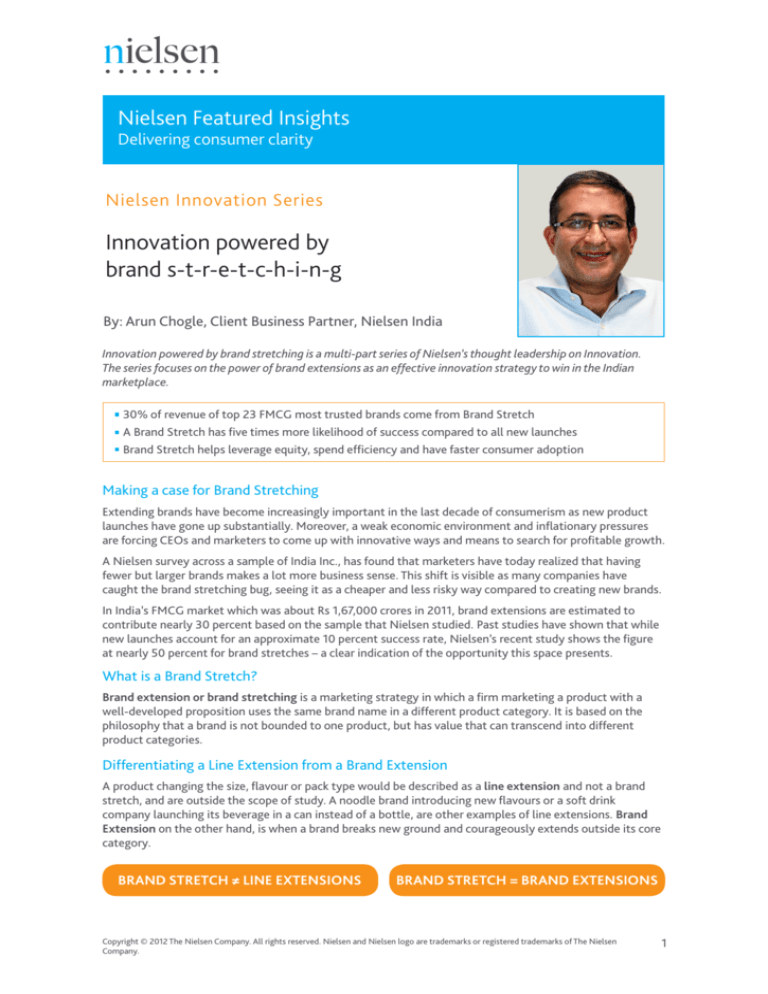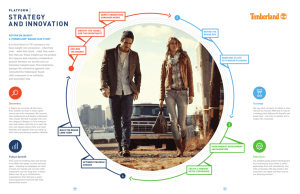
Nielsen Featured Insights
Delivering consumer clarity
Nielsen Innovation Series
Innovation powered by
brand s-t-r-e-t-c-h-i-n-g
By: Arun Chogle, Client Business Partner, Nielsen India
Innovation powered by brand stretching is a multi-part series of Nielsen’s thought leadership on Innovation.
The series focuses on the power of brand extensions as an effective innovation strategy to win in the Indian
marketplace.
30% of revenue of top 23 FMCG most trusted brands come from Brand Stretch
A Brand Stretch has five times more likelihood of success compared to all new launches
Brand Stretch helps leverage equity, spend efficiency and have faster consumer adoption
Making a case for Brand Stretching
Extending brands have become increasingly important in the last decade of consumerism as new product
launches have gone up substantially. Moreover, a weak economic environment and inflationary pressures
are forcing CEOs and marketers to come up with innovative ways and means to search for profitable growth.
A Nielsen survey across a sample of India Inc., has found that marketers have today realized that having
fewer but larger brands makes a lot more business sense. This shift is visible as many companies have
caught the brand stretching bug, seeing it as a cheaper and less risky way compared to creating new brands.
In India’s FMCG market which was about Rs 1,67,000 crores in 2011, brand extensions are estimated to
contribute nearly 30 percent based on the sample that Nielsen studied. Past studies have shown that while
new launches account for an approximate 10 percent success rate, Nielsen’s recent study shows the figure
at nearly 50 percent for brand stretches – a clear indication of the opportunity this space presents.
What is a Brand Stretch?
Brand extension or brand stretching is a marketing strategy in which a firm marketing a product with a
well-developed proposition uses the same brand name in a different product category. It is based on the
philosophy that a brand is not bounded to one product, but has value that can transcend into different
product categories.
Differentiating a Line Extension from a Brand Extension
A product changing the size, flavour or pack type would be described as a line extension and not a brand
stretch, and are outside the scope of study. A noodle brand introducing new flavours or a soft drink
company launching its beverage in a can instead of a bottle, are other examples of line extensions. Brand
Extension on the other hand, is when a brand breaks new ground and courageously extends outside its core
category.
BRAND STRETCH ≠ LINE EXTENSIONS
BRAND STRETCH = BRAND EXTENSIONS
Copyright © 2012 The Nielsen Company. All rights reserved. Nielsen and Nielsen logo are trademarks or registered trademarks of The Nielsen
Company.
1
Understanding Brand Stretch types
Nielsen reviewed the various kinds of brand extensions that marketers typically resort to and has broadly
identified three types.
Type A is where there is a change in product format but its core function remains the same. A company
manufacturing bar soaps extending to liquid sanitizer would be a good example of this type of brand stretch.
Type B is when a product shifts to an adjacent category but is still within the ambit of the larger category.
An example would be when a Corn flakes brand introduces Oats.
A Type C brand stretch is when there is a complete shift to a different category. A company extending from
a category of Spirits and Beer to a service oriented industry of Airlines would fall under this type.
THE
LANDSCAPE
FOR BRAND
STRETCHING
Degree of stretch
UNRELATED
CATEGORY
BEER
ADJACENT
CATEGORY
CORN FLAKES
FORMAT
CHANGE
BAR SOAP
LIQUID
SANITIZER
OATS
TYPE A
Adapted from Kapferer’s model on brand types
AIRLINES
TYPE B
TYPE C
Scope of the study - a view from 3 lenses
With a view to identify what the key factors are for successful brand stretches, Nielsen conducted a
comprehensive, integrated study from three different lenses.
1. Market lens: A study of the 23 FMCG brands published in the 100 most trusted brands in India having 82
brand extensions spread over 46 categories. These 23 brands along with their extensions constitute to
19 percent of the FMCG space and have a success rate of 53 percent.
The success of these brand extensions was defined as meeting either of two conditions:
• Growth of market share and distribution in two consecutive years
• Minimum of five percent market share with sales volume ranking amongst top five brands
2. The Marketer’s Lens: Soliciting preferences of marketing practitioners on the subject of brand stretch in
comparison to new brand launches. The experience of practitioners varied across sectors from FMCG,
Retail, Auto and Pharma.
3. The Consumer Lens: Finally, the consumer response on brand stretch initiatives across 66 concepts over
22 brands in Food and Non Food categories. Successful concepts were defined as the ones which have
top 25 percentile for purchase intent when compared to BASES database.
19%
165+
OF FMCG
MARKET
YEARS OF
EXPERIENCE
MARKET LENS
MARKETER’S LENS
66
CONCEPTS
CONSUMER LENS
Copyright © 2012 The Nielsen Company. All rights reserved. Nielsen and Nielsen logo are trademarks or registered trademarks of The Nielsen
Company.
2
Brand Stretches on the uptick
The contribution of Brand Stretches is significant and fast growing. According to Nielsen Audit data, the
contribution is much as almost 30 percent in 2011. The argument to focus on stretches becomes more
compelling when we see that the contribution to growth is even higher at 38 percent for the respective
brands
BRAND
STRETCHES
ARE
DRIVING
GROWTH
38.0%
29.6%
27.7%
2009
28.4%
2010
2011
% CONTRIBUTION TO BRAND
32.2%
2010
2011
% CONTRIBUTION TO
INCREMENTAL SALES
Source: Nielsen
Brand Stretch: The advantages
In today’s environment where innovations are driving growth into new benefits and new categories
Marketers are looking for launches with faster adoption rates providing the fastest ROI on the investments.
Brand stretch strategy complements this objective by extending the existing equity of the brand to a new
product.
In our survey we found Stretches are preferred by six times more practitioners compared to new a launch.
The top three benefits are:
1. Leverage Equity – Utilise the latent potential of brand to extend its equity to fulfil a wider scope of
consumer needs.
2. Spend Efficiency – Stretches offer opportunity to pool in marketing budgets across the extension,
thereby benefits of scale for advertising and promotional spends.
3. Faster Adoption – Consumers are familiar with the brand and values it stands for. This increases the
willingness to try out stretch offering of the brand and leads to faster adoption.
WHY
STRETCH
YOUR
BRAND?
DRIVE GROWTH
BY LEVERAGING
EQUITY
SPEND
EFFICIENCIES OF
SCALE
GET FASTER
CONSUMER
ADOPTION
Copyright © 2012 The Nielsen Company. All rights reserved. Nielsen and Nielsen logo are trademarks or registered trademarks of The Nielsen
Company.
3
Brand Stretches have better chance of success
Past studies show that the probability of success for new launches is only around 10 percent, making the
proposition very risky. However, when on narrowing the data to focus only on stretches, Nielsen found that
the probability of success significantly improved to 50 percent. This means stretches have five times more
chance of success compared to all launches.
STRETCHES
HAVE 5X
GREATER
SUCCESS RATE
THAN FOR ALL
LAUNCHES
1
OUT OF
10
NEW
LAUNCHES
1
2
OUT OF
BRAND
STRETCHES
Source: Nielsen
50% are still failures!
While the probability of success is higher for brand stretches, there are ample examples when stretches
have failed to succeed. It is therefore important to understand the role of marketing mix, distribution and
positioning in leveraging the essence of core values of brand as drivers of success. These learnings will be
covered in part two of the ‘Innovation powered by brand stretch’ series.
Coming up in part-II of the Innovation Powered by Brand Stretch series:
FACTORS FOR SUCCESS IN A STRETCH STRATEGY
About Nielsen
Nielsen Holdings N.V. (NYSE: NLSN) is a global information and measurement company with leading
market positions in marketing and consumer information, television and other media measurement,
online intelligence, mobile measurement, trade shows and related properties. Nielsen has a presence in
approximately 100 countries, with headquarters in New York, USA and Diemen, the Netherlands.
For more information, visit www.nielsen.com.
Copyright © 2012 The Nielsen Company. All rights reserved. Nielsen and Nielsen logo are trademarks or registered trademarks of The Nielsen
Company.
4








